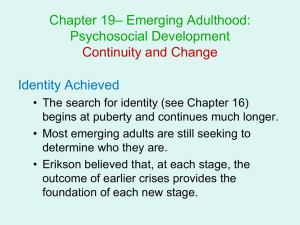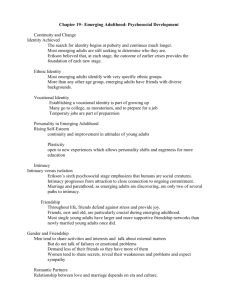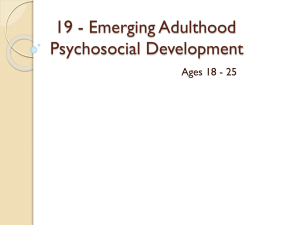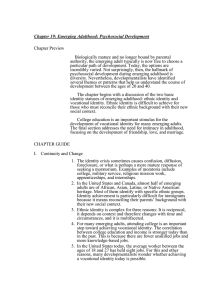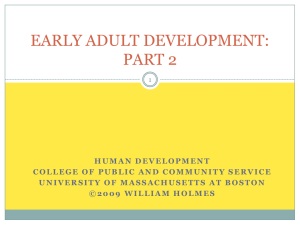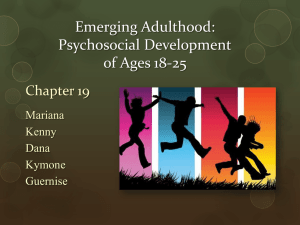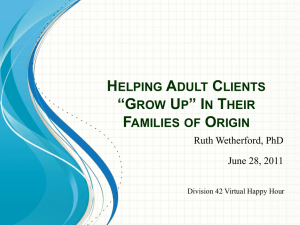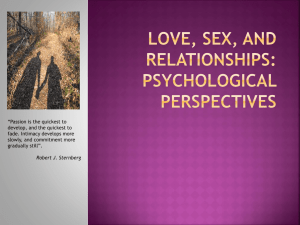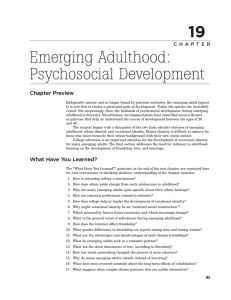Invitation to the Life Span by Kathleen Stassen Berger
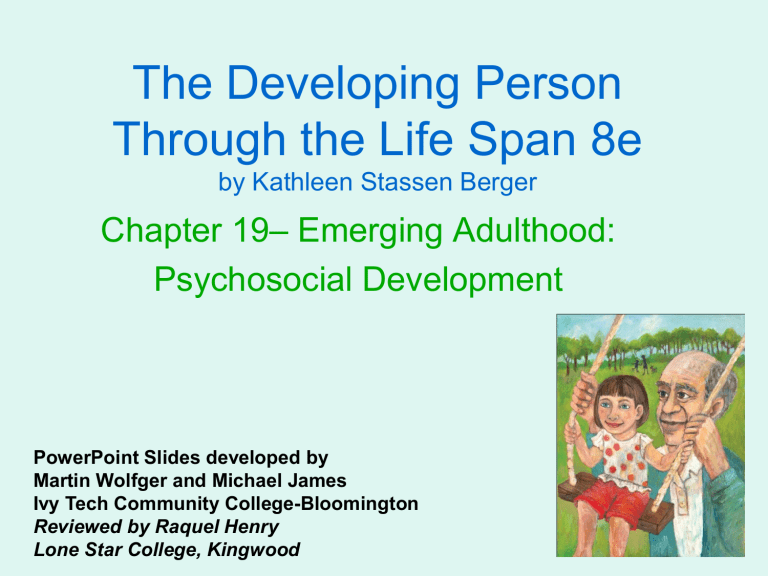
The Developing Person
Through the Life Span 8e
by Kathleen Stassen Berger
Chapter 19 – Emerging Adulthood:
Psychosocial Development
PowerPoint Slides developed by
Martin Wolfger and Michael James
Ivy Tech Community College-Bloomington
Reviewed by Raquel Henry
Lone Star College, Kingwood
Continuity and Change
Identity Achieved
• The search for identity (see Chapter 16) begins at puberty and continues much longer.
• Most emerging adults are still seeking to determine who they are.
• Erikson believed that, at each stage, the outcome of earlier crises provides the foundation of each new stage.
Continuity and Change
Ethnic Identity
• Most emerging adults identify with very specific ethnic groups.
• More than any other age group, emerging adults have friends with diverse backgrounds.
• Ethnic identity may affect choices in language, manners, romance, employment, neighborhood, religion, clothing, and values.
Vocational Identity
• Establishing a vocational identity is part of growing up
• Many go to college, as moratorium, and to prepare for a job
• Temporary jobs are part of preparation
• Young workers tend to feel no loyalty to their employer in reaction to the current global economy
Vocational Identity
Personality in Emerging
Adulthood
• Rising Self-Esteem
– continuity and improvement in attitudes of young adults
• Worrisome Children Grow Up
– children with high aggression and those with extreme shyness grew up with little pathology
• Plasticity
– open to new experiences which allows personality shifts and eagerness for more education
Intimacy
Intimacy versus isolation
• Erikson’s sixth psychosocial stage emphasizes that humans are social creatures.
• Intimacy progresses from attraction to close connection to ongoing commitment.
• Marriage and parenthood, as emerging adults are discovering, are only two of several paths to intimacy.
Intimacy
Friendship
• Throughout life, friends defend against stress and provide joy.
• Friends, new and old, are particularly crucial during emerging adulthood.
• Most single young adults have larger and more supportive friendship networks than newly married young adults once did.
Intimacy
Gender and Friendship
• Men tend to share activities and interests and talk about external matters
– But do not talk of failures or emotional problems
– Demand less of their friends so they have more of them
• Women tend to share secrets, reveal their weaknesses and problems and expect sympathy
Romantic Partners
• Relationship between love and marriage depends on era and culture.
• 3 patterns occurring roughly in thirds:
−Arranged marriages
−Adolescents meet a select group and man ask woman’s parents for permission
−People socialize with many and then fall in love and marry when they are able, the most common in Western cultures
Intimacy
The Dimensions of Love
Robert Sternberg (1988) described three distinct aspects of love:
• Passion - an intense physical, cognitive and emotional onslaught characterized by excitement, ecstasy, and euphoria.
• Intimacy - knowing someone well, sharing secrets as well as sex.
• Commitment - grows gradually through decisions to be together, mutual care giving, kept secrets, shared possessions, and forgiveness.
Intimacy
Hookups Without Commitment
• Hookups
– A sexual encounter with neither intimacy nor commitment
• Social networks
– A Web site that allows users to publically share their lives and connect with large numbers of people
• Choice overload
– Having so many possibilities that a thoughtful choice becomes difficult
Finding Each Other and Living
Together
Finding Each Other and Living
Together
Cohabitation
• Living with an unrelated person—typically a romantic partner —to whom one is not married
• Most young adults in the U.S., England, and northern Europe cohabit rather than marry before age 25.
• Half of all cohabitating couples in the U.S. plan on marrying eventually.
Changes in Marriage Patterns
In the U.S.
• Most adults aged 20-30 are not married
• Compared to any year in the past, fewer adults are married and more are divorced.
• The divorce rate is half the marriage rate
(3.6 compared to 7.3 per 1000) because fewer people are getting married.
Similarities and Differences
• Homogamy
– Marriage between people who tend to be similar
(SES, goals, religion, attitudes, local origin, etc.)
• Heterogamy
– Marriage between people who tend to be dissimilar
(interests, etc)
• Social homogamy
– The similarity of a couple’s leisure interests and role preferences.
Conflict
Learning to listen
• Demand/withdraw interaction
– A situation in a romantic relationship wherein one person wants to address an issue and the other refuses
– Women tend to be more demanding and men withdrawing.
Intimate Partner Violence
• Emerging adults experience more partner violence than those over 25.
• Alcohol and drugs make violence more likely and more severe.
• Rates are high and would be higher if selfdeception and dishonesty weren’t factors but would be lower if preventative measures were in place.
Intimate Partner Violence
• Situational couple violence
– Fighting between romantic couples that is brought on more by the situation than by personality problems
• Intimate terrorism
– A violent and demeaning form of abuse in a romantic relationship where the victim is too scared to fight back, seek help, or withdraw
Emerging Adults and Their Parents
• Linked Lives
– Where the success, health, and well-being of each family member are connected to those of other members.
• Financial Support
– Parents of all income levels in the U.S. help their adult children.
• A Global Perspective
– Parental support and linked lives are typical everywhere. In some countries, it is valued more than in others (i.e. Italy vs. Great Britain).
